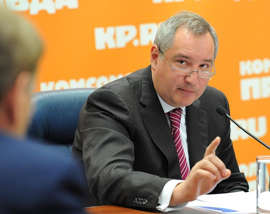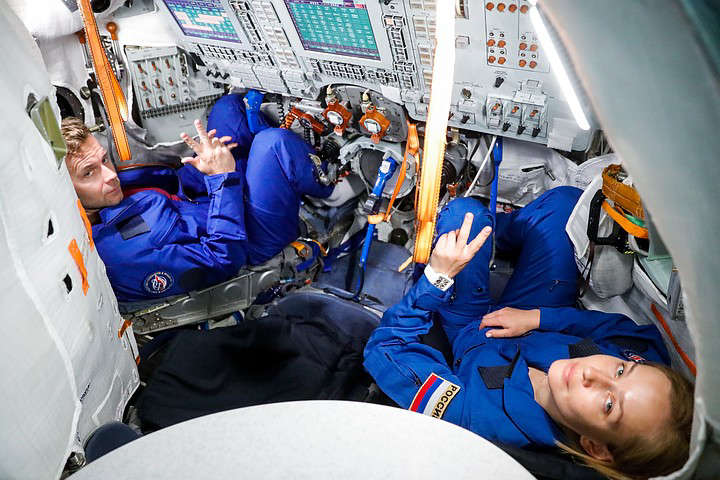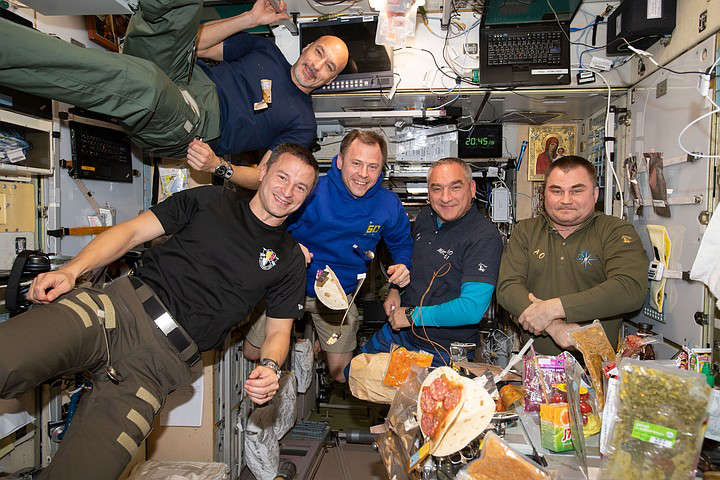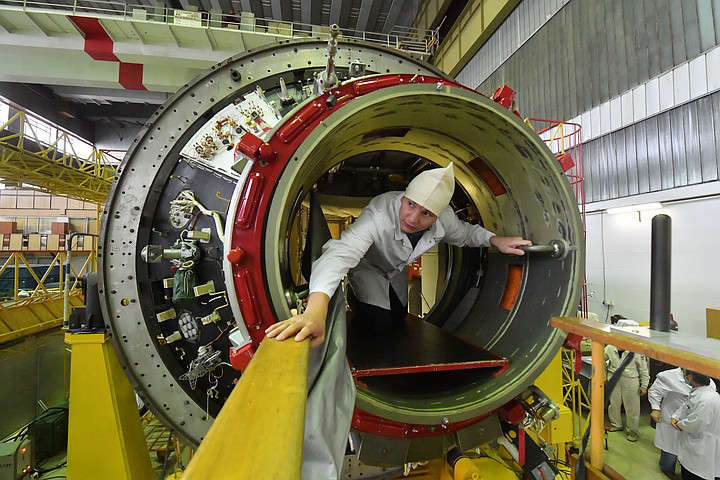
About the prospects of the ISS
– Dmitry Olegovich, let's start with the future of the International Space Station. I have heard suggestions from various sources that it is time for us to leave the ISS. And let the partners themselves handle the servicing of the segment made in Russia …
– It's impossible. The International Space Station is a complex complex. Each main participant of the ISS has its own competencies, which will be quite difficult for another participant to fulfill. It's like a common home. Everyone lives together, but everyone does their own thing.
There is a concept of partner responsibility. When it comes to gradually phasing out some government programs on the ISS, we must first figure out how other partners can keep the station afloat.
The Americans were the first to say about the need to commercialize the ISS. The station has been operating in space in a state of colossal stress for 20 years. And we, speaking of a certain reduction in the program of further work on it, associate this with its current state. Continuous technical support is required for the state of each segment of the ISS. I think, due to the dialogue with NASA, we will find an option in which, perhaps, we will transfer our participation to a commercial basis. But this does not mean that we are evacuating from the ISS.
– Is it planned to launch a multifunctional laboratory module “Science” to the ISS in July? But the other day, Deputy Prime Minister Yuri Borisov said that our program of scientific experiments planned on the ISS has ended. Why then keep astronauts there? Also send a new module …

– Let me explain what my colleague Borisov had in mind. With an orbital inclination of 51 degrees (namely, the ISS has such an inclination), the experiments that were carried out to study human behavior under these conditions were mainly carried out. These are the experiments of our partner, the Institute of Biomedical Problems.
But this does not mean that all other experiments should not be carried out on the ISS. We recently conducted an interesting experiment – we grew cartilage and biological tissues in a 3D bioprinter in zero gravity. Such materials cannot be made in the conditions of Earth's gravity.
Obviously, biomedical experiments will continue, as will telemedicine experiments. Our cosmonauts did an interesting job during the spacewalk. They have installed certain volumes on the outer side of the station, which will allow research into how outer space, radiation, and other effects of outer space affect microorganisms that are in an unprotected state. This will give us answers to the questions whether there is a possibility of transferring the elements of life from planet to planet on asteroids, on meteorites. Or even from the solar system to other star systems.

Nobody is curtailing the scientific program. There is a commission that selects these experiments. There is a very interesting proposal at the Yuri Alekseevich Gagarin Cosmonaut Training Center. The point is to stimulate scientists to prepare experiments so that in the future the developer himself will be able to take part in conducting an experiment in space.
I think this idea is interesting and reasonable.
Yes, in a sense, the potential of the ISS has been exhausted, but not completely. It can work until 2030 and even after. The question for us is fundamentally important – until what year will we, as a state corporation, participate in the work of the ISS. Or we can, say, at the turn of 2026-2028, transfer the reins of management to a certain private company that could pay for our operations on the ISS. And they are important – for example, keeping the station at a certain height or maneuvers. They are still produced by the engines of our Progress cargo ships. Perhaps, it will not be us who will pay for this, but our partners. This is a matter of negotiation.

About the long-suffering “Science”
– Is there any sense then to send the “Science” module now? Can I wait and send it as part of the national orbital station, as is planned with the scientific energy module?
– We discussed this issue. If the ISS will operate until 2030, what about the new Science module? Should it be sent to a station that is already close to retirement age?
The multifunctional laboratory module itself is the latest construction of the great Soviet era. It was created exactly according to the technologies used to create the Mir modules and the first ISS modules. Including those that were made by an American order. We would like our new station to be formed from those modules that were created according to the technologies of modern Russia.
Yes, over the past three years, we have managed to cope with the technical problems that were identified quite a long time ago in the “Science” module. However, the resource of this module is not what it would have been if it had been launched on time – that is, almost 15 years ago. We consider this resource to be approximately halved. And it will be approximately equal to the period that the ISS can still live. Why do we need a module with a limited resource for a new station? It is not right.
Therefore, we consider the scientific and energy module, which is already being made according to other technologies, as the basic module for the new station.
About tourists and filmmakers
– Isn't it too modest a task for our cosmonauts to “serve” the guests of the ISS – this year a director and an actress are to fly on our ships, then two Japanese?
– I asked myself this question. I want to answer, as I answered myself. You see, at first space was the lot of superhumans, professionals. It was they who, risking their lives, took the first steps in the exploration of outer space. Then this work became more and more routine.
Sometimes it is a shame to hear that many of our citizens do not know the names of cosmonauts, although they are outstanding people. This suggests that it is necessary to promote space, to show manned space, how difficult and risky it is. In order to tell about this, it is necessary to immerse people who are not connected with professional astronautics into life in orbit. Show the work of astronauts in artistic language.
It is not true that everything has been flying well for a long time. It is necessary to destroy this untruth not by means of animations or virtual structures, but it is necessary to show how everything really is.
Second. Tourists. We also need to make money. We have serious financial constraints, it is difficult to achieve much from our Ministry of Finance. It used to be that Soviet cosmonautics would come and say how much they needed. And she got exactly as much as they needed. Things are different now.
We have to make money ourselves, invest in the development of technologies. And for this, space tourism is a good topic. Why should we give space tourism to the Americans? Are they smarter than us or dumber? They are doing this too.
And the third circumstance. At a certain stage, we must make space more open to people. First, for those who will allow them to pay for their flights, and when we reduce the cost of these flights, expand the possibilities – our dream is to make space open to mankind. And so that in the future, opportunities for the colonization of other planets were opened. And not only the Americans should talk about this, we are also talking about it.
To ensure this kind of flights, flights, long and difficult, we must include people of various professions in the cosmonaut corps. These are geologists, doctors, biologists, physicists, astronomers. And shape the training program in a new way. When there is a professional cosmonaut, a commander who knows the ship to every bolt. And there are other specialists, useful and necessary in orbit, who need to learn how to prepare for flight in a very short period.
For short flights, for short missions, not comparable in complexity to the work of a professional cosmonaut, if there is an opportunity to train a person in just 3-4 months, this is a good result. This means that the number of people we can quickly prepare for a specific task will increase dramatically. And this expands our maneuver.
Astronautics, including manned space, in the future will be more and more open to a large number of people.
About “extra” “Unions”
– There is information that two more Soyuz ships are being laid for tourists. Do we already have a queue of people willing to fly at their own expense and give Roscosmos an opportunity to earn money?
– The order of the new ships was made for a different purpose. This is an element of our substitute. When we have in stock, as we say, “in oil,” a manned or cargo ship ready to fly into orbit even tomorrow, it creates serious insurance for us in case of emergency situations.
When I came to Roskosmos, I experienced the drama of the accident of our Soyuz MS-10 spacecraft. Due to an error in the assembly of the rocket, an accident occurred at the time of the separation of the first and second stages. And the crew was forced to fully test the emergency rescue system. But what I went through as a leader, chairman of the state commission, it is difficult for me to explain to you. These are colossal experiences when you do not know for 20 minutes whether the crew is alive or not. I'm not talking about the experiences of the astronauts themselves.
In order to fully insure ourselves, we must have an additional ship ready for takeoff. But if it is not required, then it can be used for other purposes. Here, as it were, a double blow. On the one hand, this is technical reservation, on the other hand, the possibility of commercializing manned flights.
About the features of the future Russian station
– There was information about the beginning of the development of the Russian national space station. I would like to understand how it will be fundamentally different from the same ISS?
– The very architecture of the new station will be open. What's the problem with the ISS, for example? This is a gigantic structure, it is very expensive. To make it clear – now it has solar panels about the size of a football field. But it is impossible to pull out one module and replace it with another.
We want to make the architecture open, when one module that has exhausted its resource can be replaced with another. In fact, this station can be in orbit forever. Gradually and rhythmically changing the used elements.
Second. The orbit suggested by our designers is interesting. This is an orbit with an inclination of 97-98 degrees. Now the ISS flies almost parallel to the equator, and so the station will fly vertically to it. And every hour and a half, she will visit the North Pole, and then descend, cutting circles around the entire Earth. This is the only orbit that allows every two days to pass every point on our planet. This means we have a unique opportunity to shoot everything that we need to understand and see on Earth. And analyze.
At the International Station, all work takes place inside the containment. All experiments with a few exceptions are carried out internally. And astronauts make spacewalks in order to repair and replace some structures. Or ensure the integration of the new module into the station.
For people who are more or less versed in weapons, I will explain in comparison. The new station will be akin to the Picatinny Plank (this is a system of unified mounting of various auxiliary parts – for example, sights, used in small arms – Ed.). This allows you to quickly change some equipment. The outer side of our new station, which faces the Earth, will be constantly loaded with a variety of spacecraft. They will be able to conduct both conventional visual observation and in infrared mode, radar mode, see through the night, fog. On the outer board, which looks from the Earth, you can put equipment for monitoring outer space, tracking the orbits of multi-satellite constellations, space debris, and the approach of some objects to the Earth that may threaten us.
The station will be a platform that will carry a colossal load of instruments and devices. And these vehicles will not need their own solar batteries or engines to correct their orbits. This task will be performed by the station itself.
And the crew will maintain this equipment at the station. And the pragmatism from this station will be an order of magnitude higher than from the ISS.
Yes, it should be rather national or with some kind of visiting element, but I don't see any problems here from the point of view of maintaining international cooperation. It can develop in different directions.
About the economic problems of enterprises
– At the St. Petersburg economic forum, it was announced about serious losses of the Rocket and Space Corporation Energia. The Khrunichev Center seems to be floating out of debt. But “Energy” got stuck …
– All these enterprises found themselves in an extremely difficult situation. When I came to Roskosmos, I saw the true picture, and honestly, I was horrified. I didn't know if I could handle it or not.
In addition to technical specialists, engineers, designers, customer representatives who were invited to work, I invited young specialists, economists and financiers, including those from the Federal Tax Service. And together we began to form plans for the recovery of these enterprises. They were based primarily on a serious production program. And on various measures that could reduce the burden on the specific operational activities of these enterprises.
In 2018, the problem of the Khrunichev Center was 127 billion rubles. He was practically bankrupt. We had to close it down, sell machine tools, disband people, expel and lose the leading enterprise on which we were counting in terms of the production of new generation missiles – Angara missiles. The same is “Energy”. She was bankrupt because the Sea Launch project failed. He stopped flying. The debts were hanging not on Boeing (this company was at the first stage a co-founder of the project – Ed.), But on Energia. Plus Energia ruined one device – Angosat, which was not insured, had to make a new one at its own expense in the interests of the Angolan customer. And there were several such failures.
In short, when we began to understand, tears, as they say, were in our eyes. But, nevertheless, of the 127 billion rubles of Khrunichev's debt, 28 remained. 99 billion less. Look, this is a good result. Find me more examples in our industry where a team could achieve such a colossal reduction in the burden on a leading enterprise. And I will say that we will carefully remove these 28 billion due to the fact that the Angara, which began flying on tests, will soon switch to serial production, and the volume of the enterprise's workload will increase. In 2024, we will be profitable according to our calculations.
The same goes for Energy. These losses – what? This is the same reservation of funds for the creation of a new Angosat apparatus in the interests of the Angolan partner, this is the money that is still being drawn from Sea Launch. But Energia is loaded with work. It is most important. The enterprise will get out, they will make a new station, they are now making a new ship “Eagle”. They have other tasks, no less important, including through the Ministry of Defense. I think that the new management of this corporation understands very well how to do this. And we are closely monitoring their work. We will help. They'll get out.
About the new head of the Cosmonaut Training Center
– A new leader has been appointed at the famous Cosmonaut Training Center. What do you expect from the CPC?
– Previously, the CTC was always headed by an astronaut. Probably at some time it was right. But now it is extremely important for us that this legendary training center, and there are only two of them in the world – here and among the Americans – was headed by a man who himself came from the engineering environment, worked all his life at the CPC. For many years he worked as a deputy head. He will be able to establish educational work. So that, on the one hand, traditions were not violated, and on the other hand, the Center developed and was a modern subdivision, I decided to appoint Maxim Mikhailovich Kharlamov as the chief. And his first deputy for flight training will be the current commander of the cosmonaut detachment, Oleg Dmitrievich Kononenko. I'm the first to tell you about this. This decision should take place one of these days after the approval of the new structure.
This is the same balance of interests between teachers and flying astronauts. Like a hockey coach. We have thought out such a decision, I think it will play in the right direction.
And I am also grateful to the President that on April 12 he supported our proposal to support the astronauts. The content of astronauts has been increased by 70%. And now it is about the same as that of European astronauts. This is a good compensation for the work and risk associated with this profession.
Listen to the full version of the interview on radiokp.ru: https://radiokp.ru/podcast/eksklyuziv/424562

